weight OLDSMOBILE SILHOUETTE 1997 Owners Manual
[x] Cancel search | Manufacturer: OLDSMOBILE, Model Year: 1997, Model line: SILHOUETTE, Model: OLDSMOBILE SILHOUETTE 1997Pages: 436, PDF Size: 21.87 MB
Page 12 of 436

Manual Front Passenger Seats
To use, pull up the lever on
the front
of the seat to
unlock it.
Slide the seat to where you want it.
To make sure the
seat is locked into place, release the lever and try to
move the seat with your body.
Reclining Front and Captain’s Chair
Seatbacks
All front seats recline.
To adjust the seatback,
rotate this knob. It is easier
to recline the seat if you
lean forward, taking your
weight off the seatback.
1-4
ProCarManuals.com
Page 34 of 436

Captain’s Chairs
The Captain’s chairs adjust like the manual front
passenger seats.
The seatback can be
reclined or raised by turning
the knob on the inboard side
of the seat. It is easier to
raise or lower the seatback
if you lean forward and take
the weight off the seatback.
The armrests can be lowered or raised for entering or
exiting the vehicle.
Removing the Captain’s Chairs
1. Pull the nylon strap behind the chair to release the
rear hooks from the floor pins.
1-26
ProCarManuals.com
Page 126 of 436
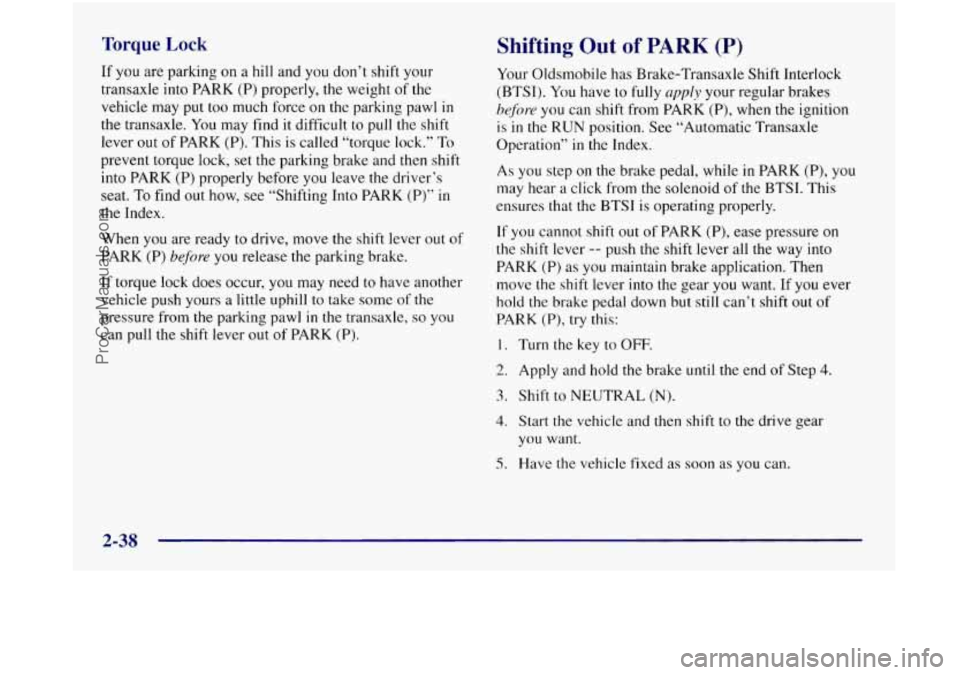
Torque Lock
If you are parking on a hill and you don’t shift your
transaxle into PARK
(P) properly, the weight of the
vehicle may put
too much force on the parking pawl in
the transaxle. You may find it difficult to pull the shift
lever out of PARK (P). This is called “torque lock.” To
prevent torque lock, set the parking brake and then shift
into PARK (P) properly before
you leave the driver’s
seat.
To find out how, see “Shifting Into PARK (P)” in
the Index.
When you are ready to drive, move the shift lever out of
PARK (P)
before you release the parking brake.
If torque lock does occur,
you may need to have another
vehicle push yours a little uphill
to take some of the
pressure from the parking pawl in the transaxle,
so you
can pull the shift lever out of PARK
(P).
Shifting Out of PARK (P)
Your Oldsmobile has Brake-Transaxle Shift Interlock
(BTSI). You have to fully
apply your regular brakes
before you can shift from PARK (P), when the ignition
is
in the RUN position. See “Automatic Transaxle
Operation”
in the Index.
As you step on the brake pedal, while in PARK (P), you
may hear a click from the solenoid of the BTSI. This
ensures that the
BTSI is operating properly.
If you cannot shift out of PARK (P), ease pressure on
the shift lever
-- push the shift lever all the way into
PARK (P)
as you maintain brake application. Then
move the shift lever into the gear you want. If
you ever
hold
the brake pedal down but still can’t shift out of
PARK
(P), try this:
1. Turn the key to OFF.
2. Apply and hold the brake until the end of Step 4.
3. Shift to NEUTRAL (N).
4. Start the vehicle and then shift to the drive gear
you want.
5. Have the vehicle fixed as soon as you can.
2-38
ProCarManuals.com
Page 168 of 436
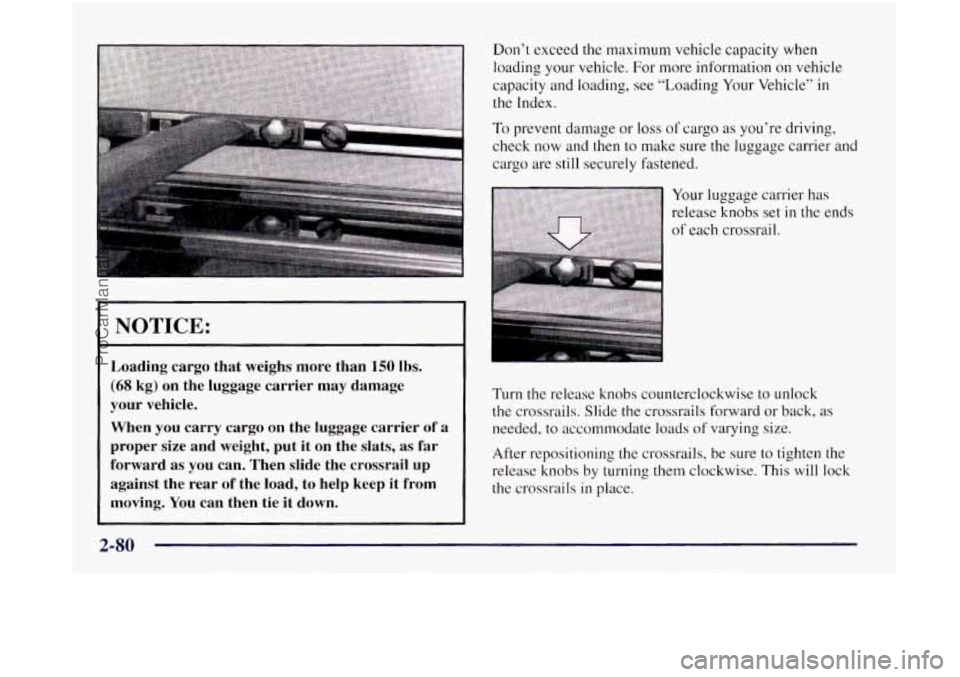
Don’t exceed the maximum vehicle capacity when
loading your vehicle. For more information
on vehicle
capacity and loading, see “Loading Your Vehicle”
in
the Index.
To prevent damage or loss of cargo as you’re driving,
check
now and then to make sure the luggage carrier and
cargo are
still securely fastened.
Your luggage carrier
has
release knobs set in the ends
of each crossrail.
NOTICE:
Loading cargo that weighs more than 150 lbs.
(68 kg) on the luggage carrier may damage
your vehicle.
When you carry cargo on the luggage carrier of a
proper size and weight, put it
on the slats, as far
forward
as you can. Then slide the crossrail up
against the rear
of the load, to help keep it from
moving. You can then tie it down.
Turn the release knobs counterclockwise to unlock
the crossrails. Slide the crossrails forward or back, as
needed, to accommodate loads of varying size.
After repositioning the crossrails, be sure to tighten the
release knobs by turning them clockwise. This
will lock
the crossrails
in place.
ProCarManuals.com
Page 229 of 436
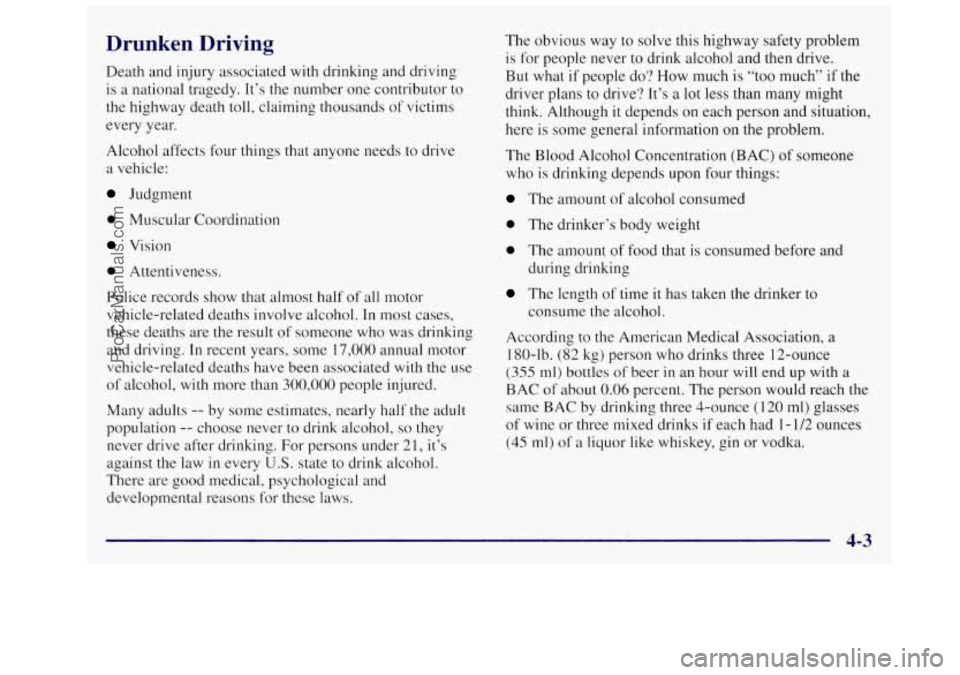
Drunken Driving
Death and injury associated with drinking and driving
is
a national tragedy. It’s the number one contributor to
the highway death toll, claiming thousands of victims
every year.
Alcohol affects four things that anyone needs to drive
a vehicle:
Judgment
0 Muscular Coordination
Vision
0 Attentiveness.
Police records show that almost half
of all motor
vehicle-related deaths involve alcohol.
In most cases,
these deaths are the result
of someone who was drinking
and driving.
In recent years, some 17,000 annual motor
vehicle-related deaths have been associated with the use
of alcohol, with more than
300,000 people injured.
Many adults
-- by some estimates, nearly half the adult
population
-- choose never to drink alcohol, so they
never drive after drinking. For persons under
2 1, it’s
against the law in every
U.S. state to drink alcohol.
There are good medical, psychological and
developmental reasons for these laws. The obvious
way to solve this highway safety problem
is for people never to drink alcohol and then drive.
But what
if people do? How much is “too much” if the
driver plans to drive? It’s a lot less than many might
think. Although
it depends on each person and situation,
here is some general information on the problem.
The Blood Alcohol Concentration (BAC)
of someone
who is drinking depends upon four things:
The amount of alcohol consumed
0 The drinker’s body weight
0 The amount of food that is consumed before and
during drinking
The length of time it has taken the drinker to
consume the alcohol.
According to the American Medical Association, a
180-lb. (82 kg) person who drinks three 12-ounce
(355 ml) bottles of beer in an hour will end up with a
BAC
of about 0.06 percent. The person would reach the
same BAC by drinking three 4-ounce
(I 20 ml) glasses
of wine or three mixed drinks if each had 1 - 1/2 ounces
(45 ml) of a liquor like whiskey, gin or vodka.
4-3
ProCarManuals.com
Page 230 of 436
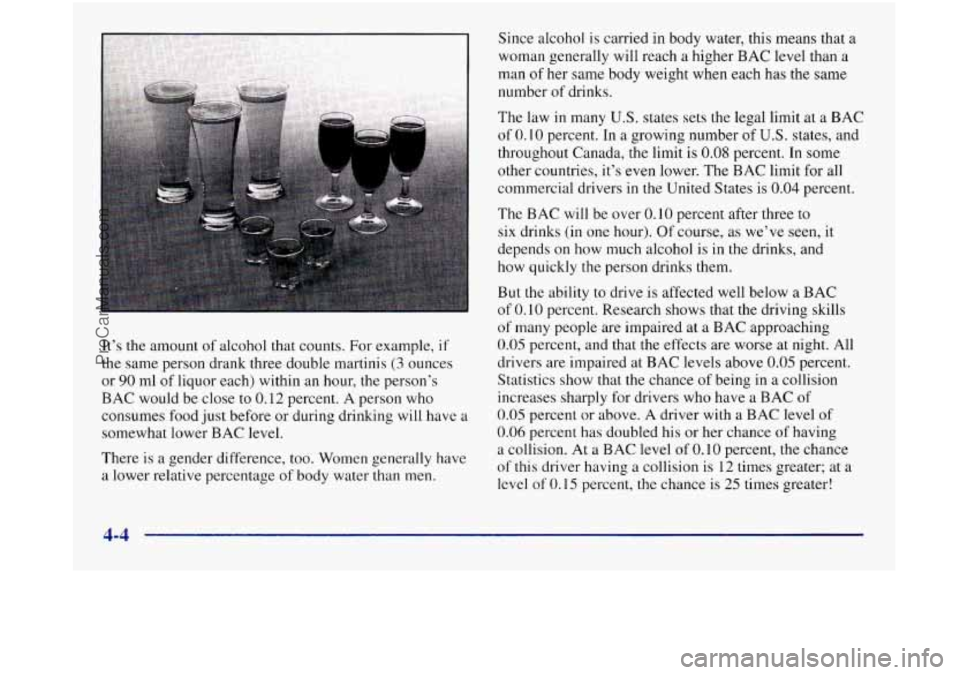
It’s the amount of alcohol that counts. For example, if
the same person drank three double martinis (3 ounces
or
90 ml of liquor each) within an hour, the person’s
BAC would be close to 0.12 percent. A person who
consumes food just before or during drinking will have a
somewhat lower BAC level.
There is a gender difference, too. Women generally have
a lower relative percentage
of body water than men. Since
alcohol
is carried in body water, this means that a
woman generally will reach
a higher BAC level than a
man
of her same body weight when each has the same
number
of drinks.
The law
in many U.S. states sets the legal limit at a BAC
of 0.10 percent. In a growing number of
U.S. states, and
throughout Canada, the limit is
0.08 percent. In some
other countries, it’s even lower.
The BAC limit for all
commercial drivers in the United States
is 0.04 percent.
The BAC will be over 0.10 percent after three to
six drinks
(in one hour). Of course, as we’ve seen, it
depends on how much alcohol
is in the drinks, and
how quickly the person drinks them.
But the ability to drive is affected well below
a BAC
of 0.10 percent. Research shows that the driving skills
of many people are impaired at a BAC approaching
0.05 percent, and that the effects are worse at night. All
drivers are impaired at BAC levels above
0.05 percent.
Statistics show that the chance
of being in a collision
increases sharply for drivers who have a BAC of
0.05 percent or above. A driver with a BAC level of
0.06 percent has doubled his or her chance of having
a collision. At a BAC level of 0.10 percent, the chance
of this driver having a collision
is 12 times greater; at a
level of 0.15 percent, the chance is 25 times greater!
4-4
ProCarManuals.com
Page 232 of 436

Control of a Vehicle
You have three systems that make your vehicle go where
you want it to go. They are the brakes, the steering and
the accelerator. All
three systems have to do their work
at the places where the tires meet the road.
Braking
Braking action involves perception time and reaction time.
First, you have to decide to push on the brake pedal.
That’s
perception time. Then you have to bring up your
foot and do it. That’s
reaction time.
Average reaction time is about 3/4 of a second. But
that’s only an average. It might be less with one driver
and as long as two or three seconds or more with
another. Age, physical condition, alertness, coordination
and eyesight all play a part.
So do alcohol, drugs and
frustration. But even in
3/4 of a second, a vehicle
moving at
60 mph ( 100 kmh) travels 66 feet (20 m).
That could be a lot of distance in an emergency,
so
keeping enough space between your vehicle and others
is important.
And,
of course, actual stopping distances vary greatly
with the surface
of the road (whether it’s pavement or
gravel); the condition of the road (wet, dry, icy); tire
tread; the condition of your brakes; the weight
of the
vehicle and the amount
of brake force applied.
Sometimes, as when you’re driving on snow or ice, it’s
easy to ask more
of those control systems than the tires
and road can provide. That means you can lose control
of your vehicle.
4-6
ProCarManuals.com
Page 255 of 436
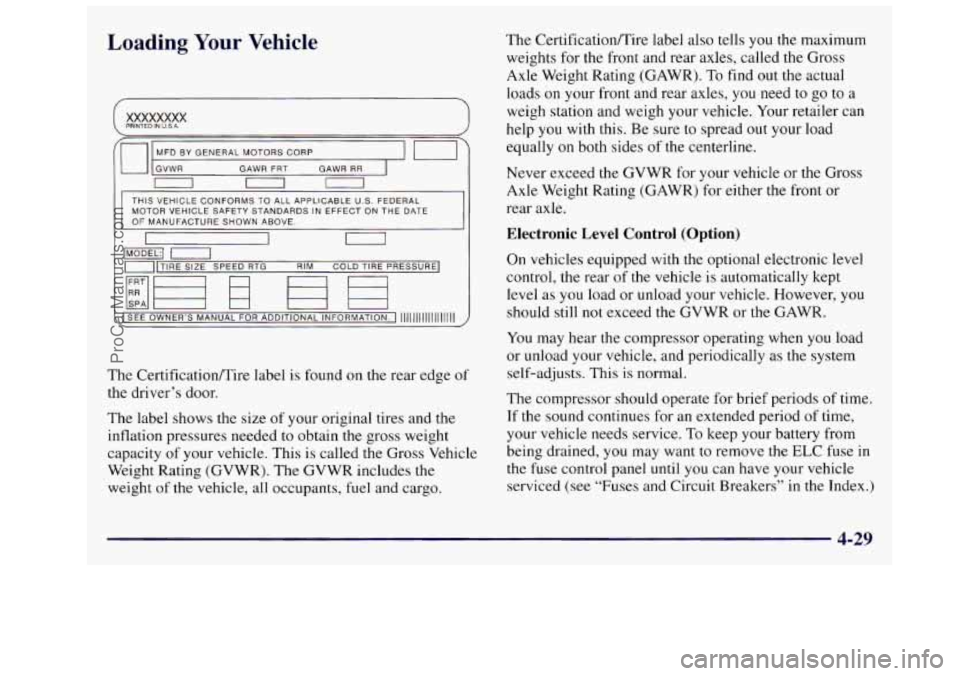
Loading Your Vehicle
XXXXXXXX PRINTEO IN U.S.A. I
‘0 GVWR MFD BVGENERALMOTORSCORP
I mi-
GAWR FRT GAWR RR
I 0 m
THIS VEHICLE CONFORMS TO ALL APPLICABLE U.S. FEDERAL
MOTOR VEHICLE SAFETY STANDARDS IN EFFECT ON THE DATE
OF MANUFACTURE SHOWN ABOVE.
I m mn
I
The Certificationnire label also tells you the maximum
weights for the front and rear axles, called the Gross
Axle Weight Rating (GAWR). To find out the actual
loads on your front and rear axles, you need to go to a
weigh station and weigh your vehicle. Your retailer can
help you with this. Be sure to spread out your load
equally
on both sides of the centerline.
. . . - - - - .
-]TIRE SIZE SPEED RTG
1- RIM COLD TIRE PRESSURE]
The CertificationRire label is found on the rear edge of
the driver’s door.
The label shows the size of your original tires and the
inflation pressures needed to obtain the gross weight
capacity of your vehicle. This is called the Gross Vehicle
Weight Rating (GVWR). The GVWR includes the
weight of the vehicle, all occupants, fuel and cargo. Never exceed the
GVWR for your vehicle or the Gross
Axle Weight Rating (GAWR) for either the front or
rear axle.
Electronic Level Control (Option)
On vehicles equipped with the optional electronic level
control, the rear
of the vehicle is automatically kept
level as you load or unload your vehicle. However, you
should still
not exceed the GVWR or the GAWR.
You may hear the compressor operating when you load
or unload your vehicle, and periodically as the system
self-adjusts. This is normal.
The compressor should operate for brief periods of time.
If the sound continues for an extended period of time,
your vehicle needs service.
To keep your battery from
being drained, you may want to remove the ELC fuse in
the fuse control panel
until you can have your vehicle
serviced (see “Fuses and Circuit Breakers” in the Index.)
4-29
ProCarManuals.com
Page 256 of 436
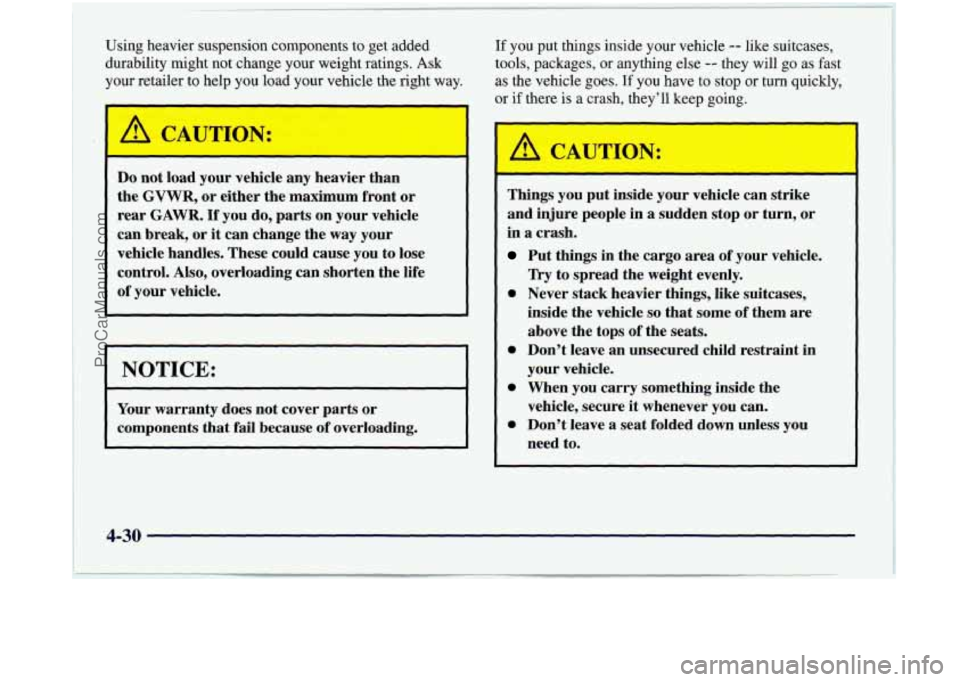
Using heavier suspension components to get added
durability might not change your weight ratings.
Ask
your retailer to help you load your vehicle the right way.
A CAUTION:
I
Do not load your vehicle any heavier than
the
GVWR, or either the maximum front or
rear
GAWR. If you do, parts on your vehicle
can break,
or it can change the way your
vehicle handles. These could cause you to lose
control. Also, overloading can shorten the life
of your vehicle.
I NOTICE:
. ,. . ~. . - .::
Your warranty does not cover parts or
. .. components that fail because of overloading. I
If you put things inside your vehicle -- like suitcases,
tools, packages, or anything else
-- they will go as fast
as the vehicle goes. If you have to stop or turn quickly,
or if there is a crash, they'll keep going.
A CAUTION:
~
Things you put inside your vehicle c
I
and injure people in a sudden stop or turn, or
in a crash.
Put things in the cargo area of your vehicle.
flry to spread the weight evenly.
0 Never stack heavier things, like suitcases,
inside the vehicle
so that some of them are
above the tops
of the seats.
0 Don't leave an unsecured child restraint in
your vehicle.
0 When you carry something inside the
vehicle, secure
it whenever you can.
0 Don't leave a seat folded down unless you
need to.
ProCarManuals.com
Page 257 of 436
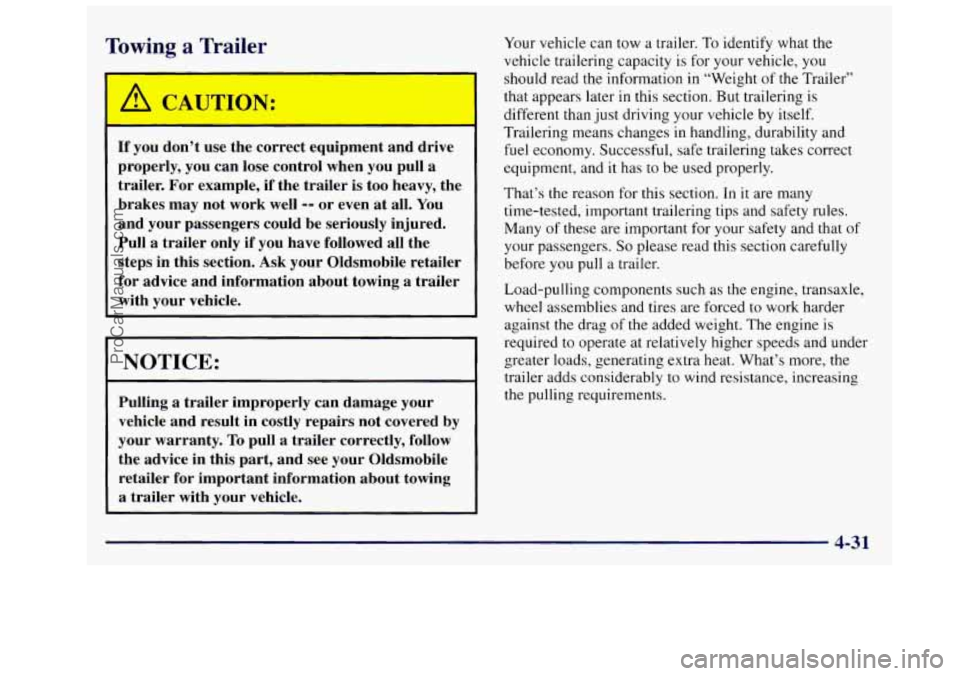
Towing a Trailer
/ CA, TKL 4:
If you don’t use the correct equipment and drive
properly, you can lose control when you pull a
trailer. For example, if the trailer is too heavy, the
brakes may not work well
-- or even at all. You
and your passengers could be seriously injured.
Pull a trailer only if you have followed all the
steps in this section. Ask your Oldsmobile retailer
for advice and information about towing
a trailer
with your vehicle.
NOTICE:
Pulling a trailer improperly can damage your
vehicle and result in costly repairs not covered by
your warranty.
To pull a trailer correctly, follow
the advice in this part, and see your Oldsmobile
retailer for important information about towing
a trailer with your vehicle.
Your vehicle can tow a trailer. To identify what the
vehicle trailering capacity is for your vehicle, you
should read the information
in “Weight of the Trailer”
that appears later in this section. But trailering
is
different than just driving your vehicle by itself.
Trailering means changes
in handling, durability and
fuel economy. Successful, safe trailering takes correct
equipment, and it has
to be used properly.
That’s the reason for this section. In
it are many
time-tested, important trailering tips and safety rules.
Many
of these are important for your safety and that of
your passengers.
So please read this section carefully
before you pull a trailer.
Load-pulling components such as the engine, transaxle,
wheel assemblies and tires are forced to work harder
against the drag of the added weight. The engine is
required to operate at relatively higher speeds and under
greater loads, generating extra heat. What’s more, the
trailer adds considerably to wind resistance, increasing
the pulling requirements.
ProCarManuals.com